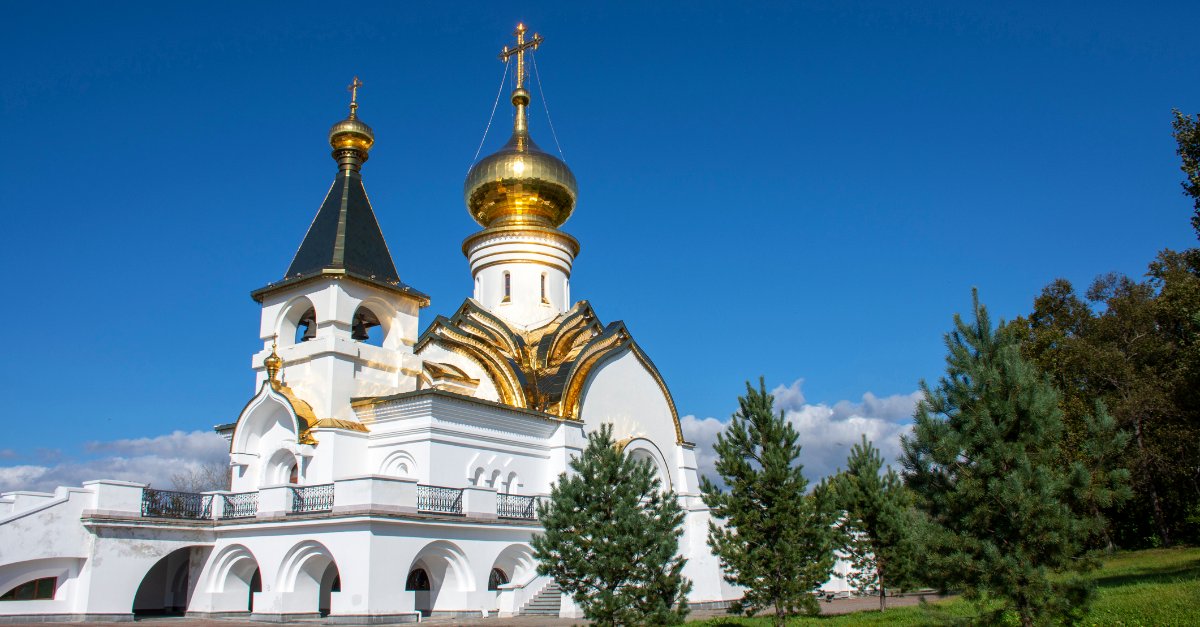
In the Russian Orthodox church, Startsi are elders from whom younger monks take advice and orders. St. Seraphim of Sarov was the original and most famous Staret. Staret literally means "spiritual teacher."
Who was Saint Seraphim of Sarov?
Saint Seraphim of Sarov was a renowned Russian Orthodox monk and mystic who is venerated both in the Russian Orthodox Church and the wider Orthodox Christian world. Born on July 19, 1754, as Prokhor Moshnin in Kursk, Russia, he later became a monk at the Sarov Monastery. He was given the monastic name Seraphim, which means "fiery" or "burning" in Hebrew, reflecting a person of intense spirituality.
Seraphim is best known for his life of prayer, ascetic practices, and his teachings on the acquisition of the Holy Spirit, which he considered the central purpose of the Christian life. He spent many years as a hermit in the forests near Sarov, engaging in deep prayer and contemplation. Despite his reclusive life, he became known for his wisdom, compassion, and the miracles attributed to him, both during his life and after his death. He often advised his spiritual children to "acquire the Holy Spirit," emphasizing the importance of inner transformation and communion with God.
One of the most famous stories about Saint Seraphim involves his conversation with Nicholas Motovilov, a layman, where he spoke about the purpose of the Christian life being the acquisition of the Holy Spirit. During this conversation, it is said that both Seraphim and the surrounding area were transfigured with divine light, exemplifying the spiritual truths he was conveying.
Seraphim was canonized as a saint by the Russian Orthodox Church in 1903. His feast day is celebrated on January 2nd (which falls on January 15th in the Gregorian calendar due to the Julian Calendar used by the Russian Orthodox Church). Saint Seraphim's life and teachings inspire many worldwide, drawing pilgrims to his monastery in Sarov and encouraging a more profound, prayerful, and ascetic Christian life.
The Teachings of St Seraphim
Saint Seraphim of Sarov's teachings revolve around the core concept of acquiring the Holy Spirit, which he considered essential for the Christian life. His spiritual guidance, although deeply rooted in the traditions of the Russian Orthodox Church, has universal appeal due to its focus on inner peace, love, and the transformative power of prayer. Here are some key aspects of his teachings:
1. Acquisition of the Holy Spirit
Seraphim emphasized that the primary goal of a Christian's life should be to acquire the Holy Spirit. He taught that through prayer, fasting, humility, and charity, a person could attract the Holy Spirit, leading to inner peace and the transformation of the soul. This acquisition was not for personal sanctity alone but was to be shared with others, spreading peace and love.
2. Prayer and Contemplation
He strongly advocated for constant prayer and contemplation as means to commune with God. Seraphim is perhaps best known for his love of the Jesus Prayer ("Lord Jesus Christ, Son of God, have mercy on me, a sinner"), which he recommended as a way to achieve continuous prayer and maintain a constant awareness of God's presence.
3. Joy and Peace
Seraphim often greeted visitors with the words, "My joy, Christ is risen!" regardless of the season. He believed true Christian joy and peace were attainable virtues for everyone, not just monks or clergy. This joy comes from the presence of the Holy Spirit within, leading to a state of inner peace that transcends worldly troubles.
4. Love and Compassion
His teachings stressed the importance of love and compassion towards all beings as manifestations of love towards God. Seraphim was known for his kindness and empathy, not only towards people but also animals, and he saw the reflection of God in every creature.
5. Spiritual Struggle
He spoke about the necessity of spiritual struggle (podvig) in the Christian life. This struggle involves battling passions and temptations through ascetic practices, prayer, and the grace of God. Seraphim himself underwent severe ascetic practices, but he tailored his advice to the capacities and circumstances of each person he counseled.
6. The Purpose of Suffering
Seraphim taught that suffering and trials could be transformative when borne with faith and patience. He saw them as opportunities to grow closer to God and to purify the soul, often quoting the Apostle Paul: "Where sin increased, grace abounded all the more."
7. Humility and Simplicity
His life and teachings exemplified humility and simplicity. Seraphim lived a life of poverty and simplicity, showing that true richness comes from spiritual wealth. He taught humility was the foundation of all virtues and the surest path to drawing near to God.

Church of St. Seraphim of Sarov. Khabarovsk. Russia
The Influence of St. Seraphim
Saint Seraphim of Sarov holds a unique and profound place in the spiritual life of the Russian Orthodox Church and beyond, impacting not only the faithful within Orthodoxy but also engaging a broader audience interested in Christian mysticism, spirituality, and the pursuit of holiness. His influence and significance can be seen in several key areas:
Spiritual Renewal and Guidance
Personal Transformation: Saint Seraphim's teachings on acquiring the Holy Spirit and his emphasis on joy, peace, and love have inspired countless individuals to seek a deeper relationship with God. His life is a testament to the transformative power of divine grace when coupled with personal ascetic effort.
Guide to Monastics and Laypeople: Although a monk and hermit, Saint Seraphim's wisdom transcends monastic life, offering guidance to laypeople in their spiritual journeys. His approachable nature and the miracles attributed to him drew people from all walks of life to seek his spiritual counsel.
Ecumenical Appeal
Beyond Orthodoxy: His teachings, particularly on the acquisition of the Holy Spirit, peace, and joy, resonate well beyond the Orthodox Church, attracting interest from other Christian denominations and those studying mysticism and spirituality. His emphasis on inner transformation is universal, making his insights relevant across Christian traditions.
Legacy of Holiness and Miracle-Working
Miracles and Healings: Reports of miracles and healings, both during his lifetime and posthumously, have contributed to his reputation as a powerful intercessor before God. These accounts have bolstered the faith of many and continue to draw pilgrims to his relics and icon.
Canonization and Veneration: Canonized in 1903, his feast day (January 2nd on the Julian Calendar) is a moment of widespread veneration and reflection on his life and teachings within the Orthodox Church. The veneration of his relics and iconography underscores his significance as a holy figure.
Influence on Orthodox Spirituality and Theology
Spiritual Literature: His conversation with Nicholas Motovilov, detailing the purpose of the Christian life, is among the most cherished spiritual texts within Orthodoxy, encapsulating the essence of Eastern Christian spirituality and theosis (deification).
Model of Ascetic Life: Saint Seraphim's ascetic practices, deep prayer life, and experience of the Holy Spirit are studied in monastic communities as a model of spiritual asceticism and contemplation.
Cultural Impact
Iconography and Art: Saint Seraphim is a popular figure in Orthodox iconography, symbolizing the Holy Spirit's transformative power in an individual's life. His image is venerated in homes and churches across the world.
Inspiration for Literature and Music: His life and teachings have inspired Orthodox hymns, religious music, and literature, contributing to the cultural and spiritual heritage of Russia and the Orthodox Christian world.
Saint Seraphim's enduring legacy is a beacon of the Orthodox Christian faith's mystical, contemplative, and ascetic dimensions. His life exemplifies the pursuit of divine union and the transformative effect of living in accordance with the Holy Spirit, making his teachings and example profoundly impactful centuries after his passing.
Tsar Nicholas wanted to appoint Seraphim as the Metropolitan of St. Petersburg. This was not to the austere monk's taste. He remained a private meditative counselor until his death.
Quotes from St. Seraphim of Sarov
"Acquire a peaceful spirit, and around you thousands will be saved."
"Where there is God, there is no evil. Everything coming from God is peaceful, healthy and leads a person to the judgment of his own imperfections and humility."
"When a person accepts anything Godly, then he rejoices in his heart, but when he has accepted anything devilish, then he becomes tormented."
"The devil is like a lion, hiding in ambush (Ps. 10:19, 1 Pet. 5:8). He secretly sets out nets of unclean and unholy thoughts. So, it is necessary to break them off as soon as we notice them, by means of pious reflection and prayer."
"It is necessary that the Holy Spirit enter our heart. Everything good that we do, that we do for Christ, is given to us by the Holy Spirit, but prayer most of all, which is always available to us."
"A sign of spiritual life is the immersion of a person within himself and the hidden workings within his heart."
"True hope seeks the one Kingdom of God and is sure that everything necessary for this mortal life will surely be given. The heart cannot have peace until it acquires this hope. This hope pacifies it fully and brings joy to it. The most holy lips of the Saviour spoke about this very hope: "Come unto Me, all ye that labour and are heavy laden, and I will give you rest" (Matt. 11:28)."
"Those who have truly decided to serve the Lord God should practice the remembrance of God and uninterrupted prayer to Jesus Christ, mentally saying: Lord Jesus Christ, Son of God, have mercy on me, a sinner."
Bibliography:
- Eerdman's Handbook to the History of Christianity. Editor Tim Dowley. Berkhamsted, Herts, England: Lion Publishing, 1977.
- Lincoln, W. Bruce. In War's Dark Shadow; the Russians before the Great War. New York: Dial Press, 1983.
- Meakin, Annette M. B. Russia Travels and Studies. Philadelphia: Lippincott, 1906.
- “Seraphim of Sarov, Saint.” Encyclopedia Britannica.
- “Seraphim of Sarov, Saint. The Oxford Dictionary of the Christian Church. Edited by F. L. Cross and E. A. Livingstone. Oxford, 1997.
- Ware, Timothy. The Orthodox Church. Hammondsworth, Middlesex, England: Penguin Press, 1964.
Photo credit: Flickr/Jim Forest; Getty/Sergey Ushpik








